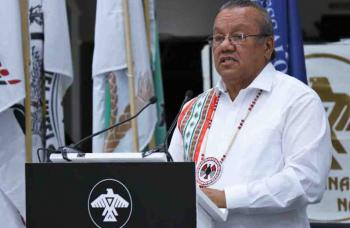Image Caption
Summary
Local Journalism Initiative Reporter
Windspeaker.com
Ontario Regional Chief Glen Hare is calling for immediate action to be taken by the federal and provincial governments after new research discovered opioid poisoning deaths among First Nations people more than doubled during the first year of the pandemic.
The reports “are very explicit in providing evidence that governments need to correct the underfunding that has been occurring for years to make effective progress on addressing the overdose crisis in First Nations communities,” said Hare.
“Every time there's a crisis, we hear ‘Let's meet. Let’s study it. Let's look at it.’ What we really need is partnerships (with governments). Let’s come to the table together about this, because we all have kids no matter what position we hold. At the end of the day this is about saving lives, about protecting our communities,” Hare tells Windspeaker.com in a phone conversation from his home nation of M’Chigeeng on Manitoulin Island.
Two new reports, prepared in collaboration with the Ontario Drug Policy Research Network, show a 132 per cent increase in First Nations’ deaths from opioids, including the painkiller fentanyl, in the year following the start of the first pandemic lockdown in March 2020 compared to the previous year.
That’s compared to a 68 per cent increase in the rest of the Ontario population. The number of First Nations’ deaths was 116 in the pandemic year, while 50 died in the year before.
Of that increase, fentanyl-related poisoning contributed to 87 per cent of opioid-related deaths. Other drugs were also involved in many of these deaths, with cocaine contributing to two out of every four fatalities and methamphetamines contributing to one-third of opioid-related deaths.
The opioid crisis was already serious before the pandemic, with drug use higher among First Nations people compared to others, according to the reports. The increase in poisonings has climbed particularly since 2017, primarily due to the growing presence of fentanyl in the unregulated drug supply.
“The COVID-19 pandemic emerged amid an opioid crisis in our communities. The findings in these reports reinforce what First Nations leadership, families and communities have been demanding for decades,” said Hare. “More needs to be done, and we must act now.”
Some of the public health measures introduced to fight COVID-19, such as border closures, restricted travel, and closure of many health centres and harm reduction sites, have led to worsening the drug crisis, the reports describe. The restrictions have resulted in a rise in use of new and unfamiliar unregulated drugs, and have created barriers for First Nations to access harm reduction services, such as naloxone and in-person treatment.
Chief Hare says he has been trying to get provincial and federal governments to pay attention to the growing opioid problem for more than a year. At a meeting in June 2020 he told officials there is “another pandemic (of drug use) looming here. Let’s focus on this.”
While the government is dealing with COVID-19 variants and climate disasters, the drug problem can’t be allowed to fall through the cracks.
“Let’s not put this on pause. We have kids dying. I want to celebrate with our communities. I’m tired of mourning. I’m tired of burying our kids and standing alongside families. We don’t need help when they’re dead. We can bury our own. We need help to keep them alive.”
The reports demonstrate the underlying systemic racism and intergenerational trauma felt by First Nations and the urgent need for appropriate access to opioid treatment and harm reduction services essential to First Nation communities to heal, he said.
“Many communities have made great efforts to strengthen community capacity through community-led programs. However, the work to implement the recommendations in these reports must expand in earnest, through true collaboration between all sectors, to see real progress, prevent future tragedies, and strengthen the healing processes so desperately needed in First Nations communities,” he said.
Other issues further hobble the response to the drug crisis, such as the lack of social workers on First Nations, Hare explained. He says those who come to work in the communities end up leaving quickly because they are offered better pay elsewhere. “Our kids who go away to school want to come back and help us, but the pay difference is night and day.”
Another problem the regional chief sees is constant change within provincial and federal governments.
“We just get something good going with them, and then there’s a Cabinet shuffle or an election. New players come on who have never been in our communities” and ask him for time to get familiar with plans former ministers were working on.
“If we can address that, we can be on the winning side of fighting drugs,” he said.
Hare welcomes steps communities have taken to fight the presence of illegal drugs on their territory, such as the screening of visitors undertaken earlier this fall at the Walpole Island First Nation in southwestern Ontario.
In November three community residents were charged and police seized quantities of suspected fentanyl, hydromorphone and methamphetamine, according to Ontario Provincial Police.
The arrests followed a declaration of emergency last July made in response to a rise in drug overdoses at Walpole. The band council introduced screening of visitors crossing the swing bridge connecting the island in the St. Clair River with the mainland in August.
The reports can be viewed here:
Local Journalism Initiative Reporters are supported by a financial contribution made by the Government of Canada.

